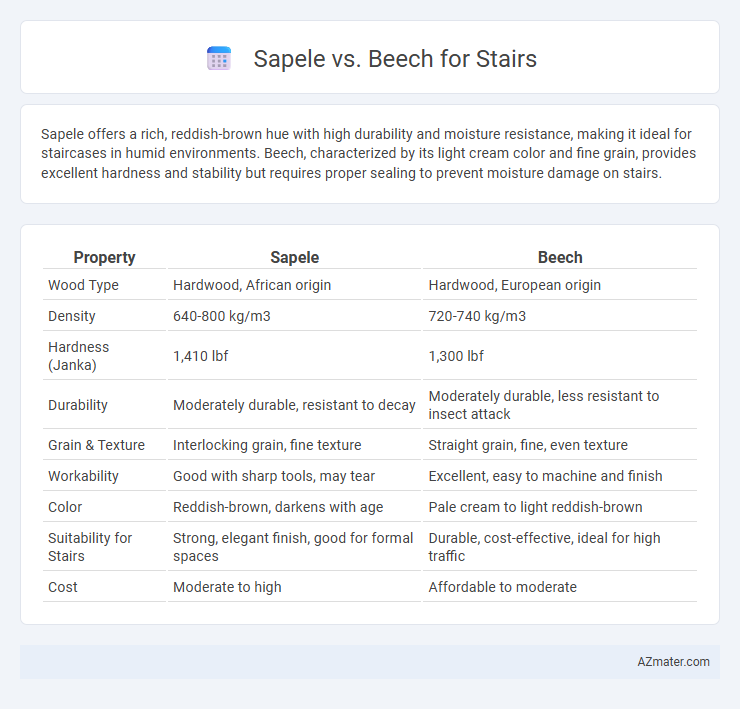Sapele offers a rich, reddish-brown hue with high durability and moisture resistance, making it ideal for staircases in humid environments. Beech, characterized by its light cream color and fine grain, provides excellent hardness and stability but requires proper sealing to prevent moisture damage on stairs.
Table of Comparison
| Property | Sapele | Beech |
|---|---|---|
| Wood Type | Hardwood, African origin | Hardwood, European origin |
| Density | 640-800 kg/m3 | 720-740 kg/m3 |
| Hardness (Janka) | 1,410 lbf | 1,300 lbf |
| Durability | Moderately durable, resistant to decay | Moderately durable, less resistant to insect attack |
| Grain & Texture | Interlocking grain, fine texture | Straight grain, fine, even texture |
| Workability | Good with sharp tools, may tear | Excellent, easy to machine and finish |
| Color | Reddish-brown, darkens with age | Pale cream to light reddish-brown |
| Suitability for Stairs | Strong, elegant finish, good for formal spaces | Durable, cost-effective, ideal for high traffic |
| Cost | Moderate to high | Affordable to moderate |
Introduction to Sapele and Beech Wood
Sapele is a durable hardwood native to West Africa, prized for its rich reddish-brown color and natural resistance to wear, making it ideal for staircase applications that require both strength and aesthetic appeal. Beech wood, originating from Europe, features a pale cream color with a fine, uniform grain and offers excellent hardness and shock resistance, which enhances the durability and smooth finish of stair components. Both woods provide reliable structural integrity for stairs, with Sapele attracting for its exotic look and Beech favored for its neutrality and ease of finishing.
Origin and Availability of Sapele and Beech
Sapele, a hardwood native to West Africa, is widely available due to sustainable plantation efforts and its popularity in furniture and stair construction. Beech, predominantly found in Europe and North America, enjoys robust availability as a fast-growing, renewable resource commonly used in interior woodworking. Both woods offer reliable supply chains but vary significantly in geographic origin and growth conditions, influencing their accessibility for stair projects.
Visual Appearance and Grain Comparison
Sapele exhibits a rich reddish-brown color with a distinctive interlocking grain that produces striking, wavy patterns, making it highly desirable for staircases that demand a luxurious, warm appearance. Beech, in contrast, features a light cream to pinkish hue with a straight, fine, and uniform grain, offering a more subtle and consistent visual appeal ideal for modern, minimalist stair designs. The dramatic, curly grain of Sapele provides a bold statement, while Beech's smooth, clean lines deliver understated elegance.
Hardness and Durability for Stair Use
Sapele wood has a Janka hardness rating of approximately 1,410 lbf, offering excellent durability and resistance to wear, making it ideal for high-traffic staircases. Beech wood, with a Janka hardness of about 1,300 lbf, is slightly softer but still provides good strength and stability for stair use. Sapele's denser grain structure enhances its resistance to dents and moisture, resulting in a longer-lasting stair tread compared to beech.
Workability and Machining Characteristics
Sapele offers excellent workability with good machining characteristics, producing smooth surfaces and clean cuts, making it ideal for intricate stair components. Beech is also highly workable, providing consistent results with minimal blunting of tools, which is advantageous for stair railings and balusters requiring precision. Both woods handle gluing and finishing well, but Sapele's interlocked grain can sometimes cause tear-out during planing, whereas Beech's straight grain ensures easier, more predictable machining.
Resistance to Moisture, Decay, and Pests
Sapele wood exhibits superior resistance to moisture, decay, and pests compared to Beech, making it more suitable for staircases in humid or high-traffic environments. Its natural oils and dense grain structure enhance durability and reduce vulnerability to fungal attacks and insect infestations. Beech, while strong and aesthetically appealing, is more prone to swelling, warping, and damage when exposed to moisture or pests over time.
Cost and Value Considerations
Sapele wood, known for its rich reddish-brown hue and durability, typically costs more than beech, but offers superior resistance to wear and moisture, making it a long-lasting choice for stairs. Beech is more affordable and easier to work with, providing good strength and a light, uniform appearance, but it may require more maintenance over time to preserve its look and structural integrity. Choosing between Sapele and Beech depends on balancing upfront cost with long-term value, where Sapele's higher initial investment often pays off in extended durability and aesthetic appeal.
Maintenance Requirements and Longevity
Sapele stairs demand moderate maintenance, requiring regular dusting and occasional oiling to preserve their rich reddish-brown hue and prevent surface wear. Beech, with its light color and dense grain, needs more frequent sealing and cleaning to avoid staining and maintain durability. Both hardwoods offer strong longevity, but Sapele typically outlasts Beech due to its superior resistance to moisture and wear.
Environmental Impact and Sustainability
Sapele and Beech differ notably in their environmental impact and sustainability for stair construction. Sapele, sourced primarily from West African tropical forests, often faces sustainability concerns due to deforestation and habitat loss, whereas Beech, commonly grown in temperate regions of Europe and North America, benefits from more regulated forestry practices and faster growth cycles, making it a more renewable option. Choosing Beech supports sustainable forestry certification schemes like FSC and PEFC, reducing ecological footprint compared to Sapele, which requires careful sourcing to ensure environmental responsibility.
Choosing the Right Wood for Your Stair Project
Sapele offers a rich reddish-brown hue and exceptional durability, making it ideal for high-traffic staircases requiring long-lasting strength. Beech, with its pale cream color and fine grain, provides a smooth finish and is easier to machine, suitable for detailed stair designs. Selecting between Sapele and Beech depends on your preference for color, wear resistance, and the complexity of the stair project.

Infographic: Sapele vs Beech for Stair
 azmater.com
azmater.com